#DENARIUS of AUGUSTUS
Text

mosaic
#but also#DENARIUS of AUGUSTUS#'greek or roman. really who can say. greek probably right'#denarius#of. of augustus.#look hear me out#might be a wild stab in the dark but#i dont think thats a greek coin m8
35 notes
·
View notes
Text

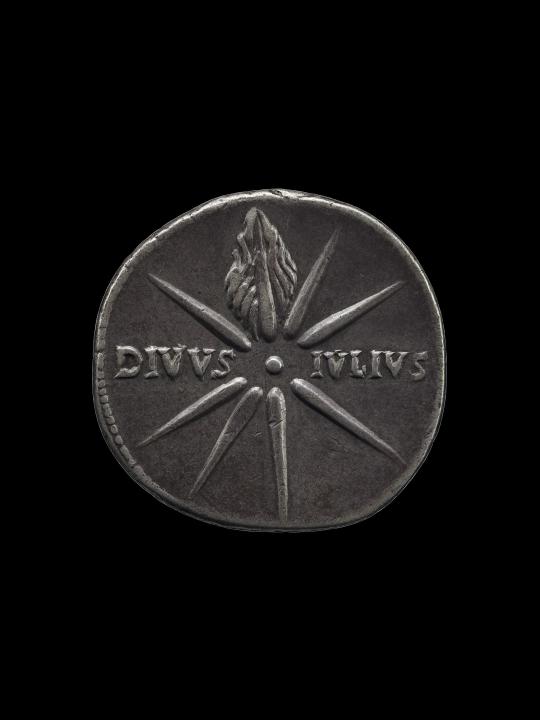
Denarius with head of Augustus wearing oak wreath (obverse) and comet with eight rays and inscription Divus Julius (reverse)
Roman (possibly minted at Caesaraugusta, modern Zaragoza in Spain), Imperial Period, 19-18 B.C.
silver
British Museum
#I love the coins of Augustus with representations of Caesar's Comet#I linked to the Wikipedia page if you want more info#denarius#Augustus#Julius Caesar#Caesar#Caesar's Comet#Divus Julius#Roman Empire#Augustan Period#Imperial Period#silver#coin#numismatics#British Museum
176 notes
·
View notes
Text
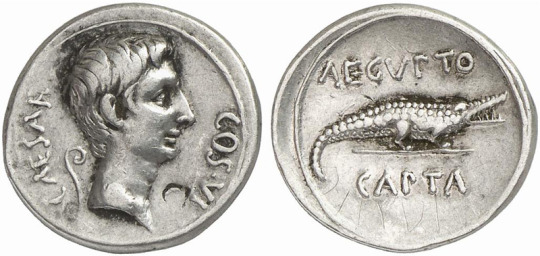
Silver denarius minted at Rome or Brundisium between 29 and 27 BCE by Julius Caesar's adopted son Octavian, soon to become Augustus. The denarius celebrates Octavian's conquest of Egypt following his (or, rather, Marcus Agrippa's) naval victory over Antony and Cleopatra at Actium. On the obverse, the bust of the young Octavian, with a lituus (ritual staff) showing his membership in the college of augurs; on the reverse, a crocodile surrounded by the inscription AEGYPTO CAPTA ("Egypt [having been] captured"). Beneath the inscription is a graffito from an unknown source. Photo credit: Classical Numismatic Group, Inc. http://www.cngcoins.com
#classics#tagamemnon#ancient history#Ancient Rome#Roman Empire#Roman history#Octavian#Augustus Caesar#Emperor Augustus#art#art history#ancient art#Roman art#Ancient Roman art#Roman Imperial art#coins#ancient coins#Roman coins#Ancient Roman coins#denarius#numismatics#ancient numismatics#metalwork#silver#silverwork
356 notes
·
View notes
Text
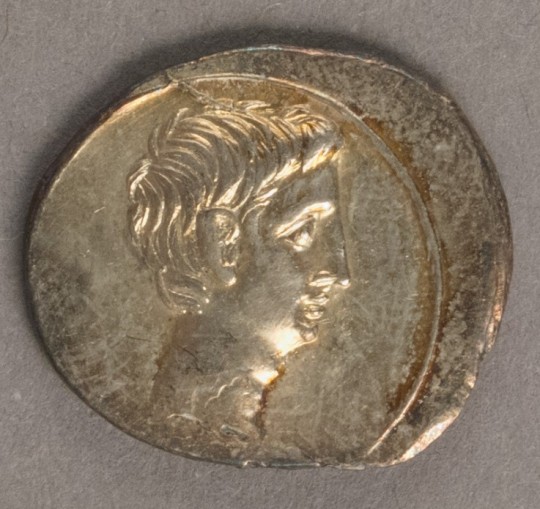
Silver denarius of Octavian (Augustus). Roman ca. 29–27 BCE. x
71 notes
·
View notes
Text
The Most Mysterious Emperor to (probably never) Exist.
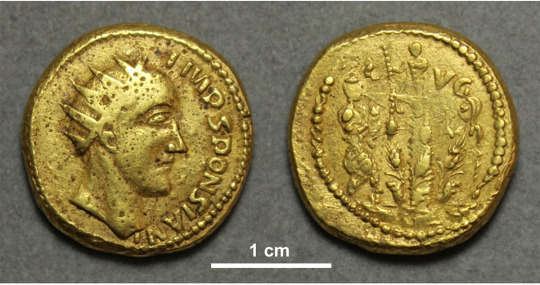
In 1713, The inspector of medals for the holy roman emperor, Carl Gustav Heraeus would note that 8 strange looking gold coins had come into the possession of the Imperial Collection of Vienna. Carl had apparently acquired these coins from the Hapsburg finance minister Johann David von Palm, who in turn had gotten them from a supposed hoard found in Transylvania.
The hoard mainly consisted of an assortment of strange types, ranging from a large gold coin of Gordian III to strange "aurei" of Philip that use a republican obverse, and even a whole gold version of an old Republican denarius.
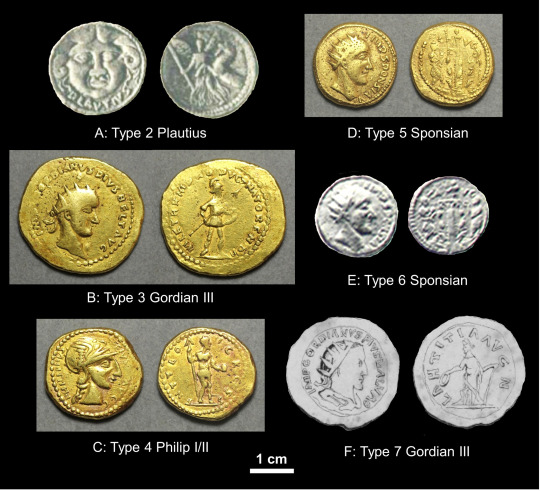
The coins themselves are all very odd, but one type among them stands out for being the strangest of them all, that being the gold coins of the emperor Sponsian, who was unrecorded in history up until the hoard's discovery, and who presumably had all of the hoard coins minted to pay either his soldiers or officials.
Sponsian's gold coins are extremely odd to say the least, and the following is a list of all the details about the coin that differ from the normal imperial issues of the time.
1. The weight is extremely heavy for Roman gold coins, the known Sponsian coins range from weighing 9 to 11 grams. No official Roman or barbarian imitation gold coins weigh that much.
2. The obverse of the Sponsian coin is strange in a few ways.
As noted above, the weight is far too heavy to be an aureus, therefore it is speculated that the coins are of the binio / double aureus denomination due to the radiate crown on Sponsian's head, which on Roman coins is indicative of a double denomination.
It is more likely that they are supposed to be donative coins meant to pay senior officers, although typical donative coins were usually made with spectacular engraving, and the Sponsian coins are just about as far off from that as possible.
The way the legend is lumped to one side of the coin is also never seen on any other official imperial 3rd century issues.
3. The reverse is arguably stranger than the obverse, as it uses a very old Republican design from 135 B.C.
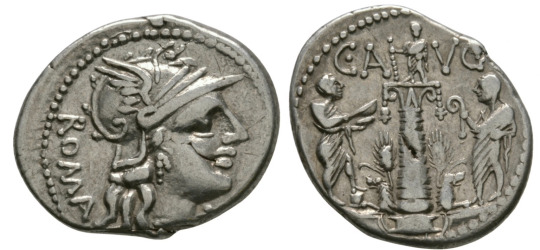
This original republican denarius was meant to commemorate a grain donative and struck by a certain Caius Augurinus, whose name can be seen at the top of the reverse "C AVG".
The use of republican reverses on 3rd century era coinage is unheard of (especially extremely obscure ones such as this), with the Sponsian coins being the only exception. Could Sponsian be calling back to his republican era ancestor Caius?
Not likely.
If these coins are from the 3rd century, the most plausible explanation is that whoever had them engraved for Sponsian had the Republican denarius on hand as a reference and assumed that the "C AVG" on the reverse meant "Caesar Augustus". The Philip coins that were found in the hoard support the theory that the engraver had the Caius Augurinus denarius as a model, since those coins use the obverse of the republican denarius for their design.
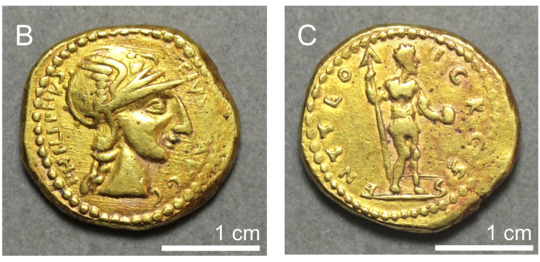
4. The Sponsian coins are undoubtedly cast, which is typically indicative of a fake coin. The problem with the coins being cast is that no 3rd century coins were ever cast, as all official issues were always struck.
There is also no hoard evidence of more Sponsian coins. Another emperor that was proven to exist was Domitian II, who was also brushed off by some numismatists as being a fake (the theory being that his coins were tooled issues of Tetricus) but another example of his coinage was unearthed in a hoard of undoubtedly genuine coins later on, finally proving his existence. If more Sponsian coins are found in a hoard containing genuine coins, it could possibly be evidence that the coins are from antiquity.
(it is noteworthy that the coins of Domitian II are not nearly as weird as Sponsian's coins, and are much easier to accept as real).
We don't know anything about the initial discovery of the Transylvania hoard and we don't even know exactly how many coins were found, but throughout the 18th century the hoard would be dispersed into collections across Europe.
During the period from the hoard's discovery and 2020, many numismatists had the chance to speak on the Sponsian coins. Their theories on the mysterious pieces ranged from the coins being Barbarian imitations, to the coins being blatant 17th century forgeries. But amidst the limited discussion during the years after 1713 surrounding the Sponsian coins, a general aura of mystery still was associated with them.
In 2020, light discussion on the Sponsian popped up again, this time on a Coin discussion forum. At this point Sponsian was very obscure, with only one photo of one of his coins being known at the start of the thread, the same photo was the one being used by Wikipedia on their page about Sponsian.
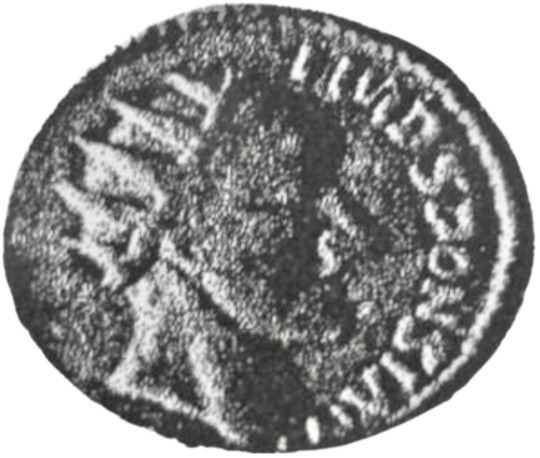
The initial discussion mainly surrounded Sponsian's strange name and trying to find more drawings / photos of the Sponsian coins.
In comes Professor Paul Pearson, who finds more photos of the Sponsian coins, and eventually requests the Hunterian museum to take the photo at the very top of this post. It is my belief that Pearson was inspired to write his famous paper on Sponsian because of his interest in this thread.
Fast forward to 2022, Pearson's paper comes out and proves that the Sponsian coins are ancient and NOT 17th century fakes.
The way Pearson concluded they were real was by analyzing the wear patterns and comparing them to some other genuine gold coins of the period in the same museum. Towards the end of the paper he also theorizes that Sponsian was a rebel in Dacia during the reign of Gallienus, and made these coins to pay his officers.
Alright, now I'm going to need you to forget the narrative that Sponsian ever actually existed.
See, in order for a newly discovered emperor on a roman coin to even remotely be considered as genuine, the coins bearing their name and image at the very least have to follow the specific patterns that other known 3rd century issues follow.
If you're a roman usurper trying to prove legitimacy, one of the first things you do is mint coins bearing your image and name in the typical imperial style to pay your troops. The coins would also have to be similar weights to those of official issue, to make sure they could function properly in the Roman economy.
For example, take the emperor Silbannacus.
He follows the same story as Sponsian in the sense that he was not recorded in any historical record until the discovery of his coins. But instead of being widely criticized by Numismatists for being a fraud, the majority of the Numismatic community is far less skeptical of his coins for the very reason that they followed all the right patterns when it came to Imperial coinage.
There is just way too many weird things going on with the Sponsian coins. All of the right patterns that the Silbannacus and Domitian II coins follow, the Sponsian coins throw out the window.
From the coins being far too heavy, the use of the Republican era reverse, the fact that they're cast. Nothing here adds up.
There are flaws with Pearson's conclusion about the coins being a genuine product from a 3rd century usurper. Although his analysis of the coin's history is solid, the means of determining the coins are from antiquity kind of fall apart when scrutinized.
For one, you can't prove a coin is ancient just because it has scratches on it that are similar to ones on an ancient coin.
There is just no definitive way to date the wear on the Sponsian coins.
Wear can also be easily faked, Pearson even admits this in his paper, as he brings up the forger Carl Wilhelm Becker and how he used iron filings to fake wear on his coins as an example.
It is also important to remember that they were in various collections during the 300 years since they were found, and during that time there is a possibility that they were handled carelessly by numismatists and others due to the fact proper precautions for handling ancient coins were not in place during those years. The wear could've developed from them.
The study done on the earthen deposits is also quite flimsy, there is simply not enough research on deposits in general, and the research conducted on them in Pearson's paper is too surface level to prove much.
We don't know how long those deposits take to form, we don't know if they were formed in the ground or during the coin's stay in the Hunterian collection etc etc.
It's very silly to immediately jump to the conclusion that Sponsian was real just because of these few flimsy points in the face of all of the things alluding to the coins being fake.
During the period after the paper's publication and the media coverage of Sponsian, many rebuttals would be made by numismatists and Roman historians alike, but one series of videos that I followed made by Guy de la Bédoyère covering Sponsian pointed out even more solid evidence against Sponsian.
In the last part of his series (and the only one left public on his yt channel) Guy talks about a book that he recently reread written a bit before the Sponsian hoard's discovery by a scholar named John Evelyn. In one of the chapters pertaining to fakes, Evelyn mentions a hoard of heavy gold forgeries imitating Roman issues discovered during the siege of Bonn in 1673. Later on, while listing off Emperors that were commonly faked, he states "and to these add such as borrow the head of some emperor with some fantastic reverse, or enigmatical inscription, which has no relation to the person, or appertain to some other, or seeming to historize some new and extravagant thing, never heard nor read in any good author before".
(I highly recommend checking out Guy's full video, I'll have it linked at the end)
The Bonn hoard of coins as well as Evelyn's description of fantasy fakes is solid evidence that forgeries similar in style and manufacture of the Sponsian pieces did exist in the 17th and 18th centuries.
Although I'm a firm believer that the coins are fake, at this point this mystery technically isn't 100 percent solved until better research on the earthen deposits is conducted, or if a new hoard of Sponsian coins is found alongside genuine issues.
Sources linked below, highly recommend reading then / watching them if you're interested in Sponsian.
youtube
youtube
3 notes
·
View notes
Photo
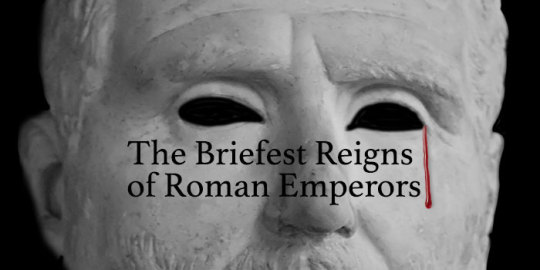
Short Timers on Ancient Coins: The Briefest Reigns of Roman Emperors
UNEASY LIES THE HEAD THAT WEARS A CROWN.
—SHAKESPEARE, HENRY IV, PART II (1597)
ROMAN EMPERORS RARELY wore an actual crown. They are more commonly shown wearing a laurel wreath or a diadem, the jeweled headband that was an ancient emblem of royalty. But the mortality statistics were enough to make any imperial head uneasy. Over 70 percent died by assassination, suicide, or in combat. Between 27 BCE and 395 CE, the average length of an emperor’s reign was just 5.6 years. But many lasted for a much shorter span of time.
Yet Roman mints were so efficient that even in a reign of a few weeks, it was possible to produce an extensive coinage, often with lifelike portraits of the ruler and his family. Every new ruler knew it was important to show the people his face on their money. Some of these coins are quite rare, but many are surprisingly common and affordable today.
Gordian I and II: 21 Days:
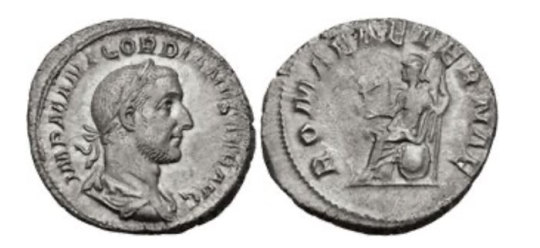
Armies in all eras tended to promote big men; their physical size and strength commanded respect and obedience.
Maximinus Thrax was a giant, eight feet tall (2.4 meters) according to the notoriously unreliable Historia Augusta. Of peasant stock, he rose through the ranks to command a legion on the northern frontier, and in 235 CE his mutinous troops murdered the Roman emperor Alexander Severus and his powerful mother, Julia Maesa. The army proclaimed Maximinus the new emperor, and the Senate grudgingly assented.
Like many rulers of humble origin, he hated aristocrats and made the mistake of alienating the Senatorial elite without exterminating it. He never set foot in the city of Rome and may have been illiterate (unusual for a third-century legionary officer). In 238 (the famously chaotic “Year of Six Emperors”), the province of Africa (today Tunisia and part of Algeria) rose in revolt against Maximinus. Leading the rebellion at Carthage was a distinguished elderly provincial governor, Marcus Antonius Gordianus Sempronianus. The Senate quickly recognized him as Emperor Gordian I “Africanus”. Because of his advanced age (about 80), he insisted on making his adult son co-emperor as Gordian II. The governor of Numidia (now parts of Algeria and Morocco) remained loyal to Maximinus and advanced against Carthage. Gordian II was killed in battle and his father committed suicide after a reign of just 21 days (March 22 – April 12, 238).

Incredibly, three weeks was sufficient time for mints at Rome and Alexandria to produce an extensive coinage in the names of both Gordians, bearing their portraits. A denarius of Gordian I currently brings between $1,500 to $3,000 USD at auction, while one of Gordian II can sell for twice as much. The inscriptions for the father and the son are identical but the portraits are distinctively different.
Numismatist David Vagi writes:
The elder Gordian has a full head of hair, a thin face, a beaked nose, and a slightly recessed jaw. The younger Gordian has a receding hairline, a long flat nose, a pronounced forehead, heady jaw and jutting chin, and is fleshier in appearance.
Diadumenian: About 1 Month:
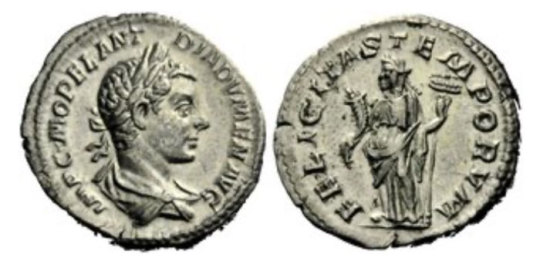
The fate of child emperors was often tragic.
Born in 208, Marcus Opellius Antoninus Diadumenianus was the son of Macrinus, who was Praetorian Prefect (palace guard commander and senior advisor) to Emperor Caracalla. Macrinus seized the throne after murdering Caracalla. At the age of eight, Diadumenian received the title of Caesar – in effect, heir apparent. Caracalla’s aunt influenced the troops of the eastern legions to proclaim her 14-year-old grandson, Elagabalus, as emperor, using the rumor that the boy was actually Caracalla’s son. At some point, Macrinus promoted his own son to Augustus (co-emperor).
Defeated in battle near Antioch, on June 8, 218, Macrinus was captured and executed. With a few trusted guards, Diadumenian fled to seek sanctuary in the Parthian Empire but was intercepted and beheaded at the age of 10. His head was sent as a trophy to Elagabalus, who himself was only a few years older.
Coins of Diadumenian as Caesar are scarce, but those of his brief reign as Augustus (perhaps less than a month) are extremely rare. In a 2014 Swiss auction, a denarius – one of just four known – sold for over $38,000.
Didius Julianus: 66 Days:
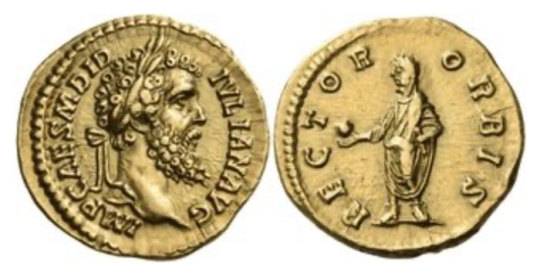
On March 28, 193, disgruntled Praetorian guards stormed the imperial palace and murdered the stern emperor Pertinax, who had reigned for only 86 days (see below). The 18th-century English historian Edward Gibbon elegantly recounts what happened next:
The more prudent of the Praetorians ran out upon the ramparts; …and, with a loud voice, proclaimed that the Roman world was to be disposed of to the best bidder by public auction. This infamous offer, the most insolent excess of military license, diffused a universal grief, shame, and indignation throughout the city. It reached at length the ears of Didius Julianus, a wealthy senator…
Senator Didius Julianus and another man, Sulpicianus (the father of the murdered emperor’s wife, Titiana), began to bid ferociously against each other for the throne. Julianus won the auction with an extravagant promise of 25,000 sestertii for each of the 8,000 guardsmen. Romans of this era commonly expressed large sums of money in terms of the bronze sestertius. The winning bid was equivalent to 6,250 silver denarii, or 250 gold aurei per man!
Julianus quickly ordered the mint to produce coins promoting his imperial reign and honoring his wife, Manlia Scantilla, and daughter, Didia Clara. On the reverse of his gold aureus, he holds a globe and proclaims himself RECTOR ORBIS – “Master of the World.” Nervous about the loyalty of his army, his most common reverse type is CONCORDIA MILITUM – “Consent of the Soldiers.”
Julianus proved deeply unpopular, and civil war loomed as three major armies revolted against him, led by Clodius Albinus in Britain, Pescennius Niger in Syria, and Septimius Severus in Pannonia on the Danube. Severus won the race for Rome and Julianus, deserted by the Praetorian Guard (which had yet to receive its promised payment), was deposed by the Senate, captured, and beheaded.
During a reign of just 66 days, the mint of Rome managed to turn out three different types in gold, three in silver, and six in bronze!
Pertinax: 86 Days:
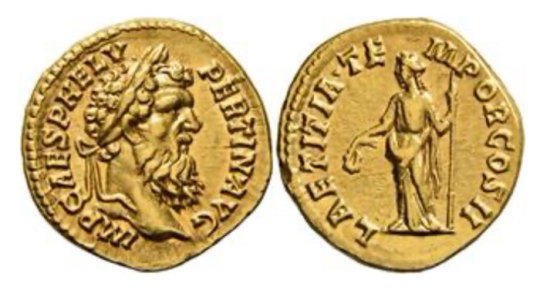
Born in the year 126, Publius Helvius Pertinax was the son of a slave who gained his freedom and prospered in the wool trade, providing a good education for his son, who then rose through the ranks of the army and became a senator and provincial governor. Following the assassination of Commodus on the last day of the year 192, Pertinax was chosen by the Praetorian Guard to become emperor.
A capable and responsible ruler, Pertinax restored the weight and quality of the silver coinage, which had deteriorated under the previous emperor. His attempts to reduce corruption and impose military discipline on the unruly Praetorians were resisted, and he was murdered after a reign of just 86 days.
During this brief time, the mint of Rome managed to issue six types in gold, 10 in silver, and 13 in bronze! A common reverse type was PROVIDENTIA DEORVM (“Providence of the Gods”), depicting the standing female personification of “providence in the sense of a prescient power caple of creating or altering future events.”
Otho: 92 Days:
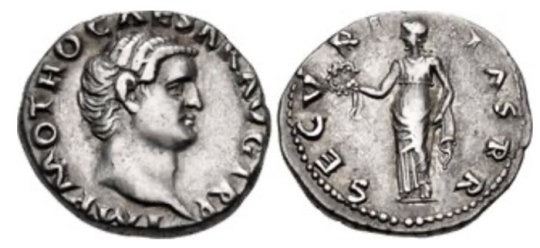
OTHO, WHO IS DESCRIBED BY TACITUS AS “AN EXTRAVAGANT YOUNG MAN”, WAS RENOWNED FOR HIS EFFEMINACY AND VANITY, AND WAS PARTICULAR ABOUT HIS GROOMING. HE IS FAMOUS TO NUMISMATISTS FOR HIS WELL-MADE TOUPEE, WHICH APPEARS AS A LUXURIANT HEAD OF HAIR ON HIS IMPERIAL PORTRAITS (VAGI, 189).
Remembered as the “Year of Four Emperors”, 69 CE was a chaotic period that followed the suicide of Nero.
On January 15, Marcus Salvius Otho organized a coup that overthrew and killed his former friend, the emperor Galba. Otho’s unusual name was of Etruscan origin. Nero had forced Otho to divorce his wife, the beautiful Poppaea Sabina, so that Nero could marry her, and sent him to govern distant Lusitania (now Portugal).
Soon, however, the powerful Roman army on the Rhine frontier marched on Rome, determined to depose Otho. When his army was defeated in Northern Italy, Otho committed suicide on April 16 or 17. He was 36 years old.

With a reign of just three months, Otho issued only gold and silver coins. The most common reverse, inscribed SECVRITAS, bears the personification of “Security”. Some elegant bronze fantasies were created during the Renaissance to fill the demand for sestertii of Otho. These fakes can be quite affordable.
For collectors determined to complete a set of the “Twelve Caesars”, Otho is one of the most challenging rulers, since coins in high grade are very scarce. A silver denarius in Very Fine condition currently goes for about $1,000 to $3,500, while a gold aureus brings anywhere from $10,000 to well over $100,000 depending on grade.
Aemilianus: 2-3 Months:
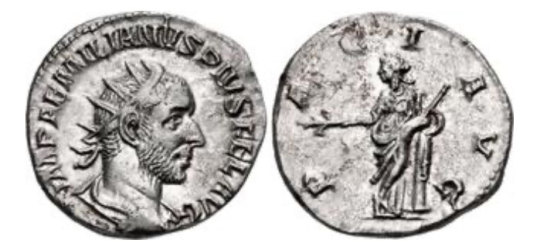
Born in Mauretania in Africa about the year 208, Marcus Aemilius Aemilianus was commanding the legions on the Danube when his troops, rebelling against the unpopular Trebonianus Gallus, proclaimed him emperor in August 253. When Aemilianus invaded Italy, Gallus and his son Volusian were murdered by their own troops – a common fate of third-century emperors.
In Aemilianus’ reign of two or three months, the mint of Rome struck three types in gold, over 20 types in silver, and about 13 types in bronze for Aemilianus. A few very rare silver antoniniani were issued in the name of his wife, Cornelia Supera, who is otherwise unknown to history. Ironically for this war-torn era, many reverses honor Pax, goddess of peace. When another general, Valerian, was proclaimed emperor by his army and invaded Italy, Aemilianus was murdered at a bridge near Spoleto that came to be known as Pons Sanguinarius (“Bloody Bridge”).
Marius: 2-3 Months:
In the turbulent year 269 CE, a blacksmith who had risen through the ranks of the Roman army on the Rhine was proclaimed emperor by his troops under the name “Marcus Aurelius Marius”. He reigned for just two or three months before he was executed–according to legend, his end came at the edge of a sword he had forged in his previous career.
In this short reign, a considerable volume of coinage – mostly silvered bronze – was produced, probably to pay the troops. These coins of Marius are quite affordable. Only about nine gold aurei of Marius exist, seven in museums.
Florianus: Less than 3 Months:
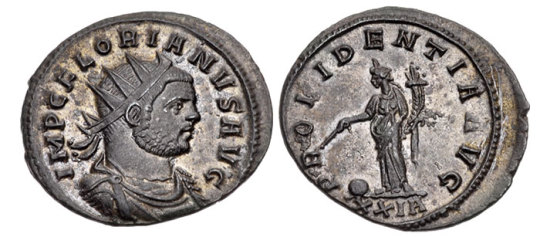
Born in 232 CE, Marcus Annius Florianus (or “Florian”, still a popular boy’s name in Romania) was the younger half-brother of Tacitus, a distinguished senator who became emperor at the request of the Senate following the murder of Emperor Aurelian in September 275.
When Tacitus died, either from illness or assassination (sources differ), Florianus, then serving as Praetorian Prefect, declared himself emperor. At the same time, Probus, a senior general commanding the powerful armies of the East, was proclaimed emperor by his legions in Syria and Egypt. The inevitable clash came in the mountains of Cilicia, and Florianus was killed by his own disgruntled troops after a reign of fewer than three months.
A silvered bronze antoninianus of Florian in extremely fine condition can be found for under $100, with even the finest Near Mint State examples going for under $500. High-grade examples of the very rare gold aureus sell for as much as $200,000 when one comes to market every few years.
Pupienus and Balbinus: 3 Months:
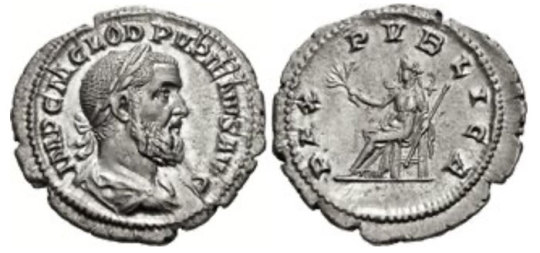
The death of the two Gordians in 238 (see above) created a power vacuum in Rome.
With the army of Maximinus poised to invade Italy and wreak bloody vengeance on the Senate, the senators responded by electing two distinguished elders, Marcus Clodius Pupienus and Decimus Caelius Calvinus Balbinus, to serve as co-emperors. Pupienus was named first in official inscriptions – a source of irritation to his colleague, who claimed a better aristocratic pedigree. The common people, who loved the Gordians, insisted that a surviving 13-year-old grandson of Gordian I be proclaimed as heir to the throne: the future Gordian III.
On July 29, 238 CE, disgruntled Praetorian guardsmen stormed the palace, dragged out the two co-emperors, and hacked them to death.
In an outburst of creative productivity, the mint of Rome turned out 29 different coin types for Pupienus (one in gold, 14 in silver, and 14 in bronze) and 23 for Balbinus (one in gold, 10 in silver, and 12 in bronze) during this reign of 99 days. Ironically, although the two co-emperors despised one another, a common reverse type is a pair of clasped hands, with the inscription FIDES MVTVA AUGG (“Mutual Trust of the Emperors”).
During this reign, the relatively pure silver denarius was gradually phased out in favor of the debased antoninianus, over-valued at two denarii.
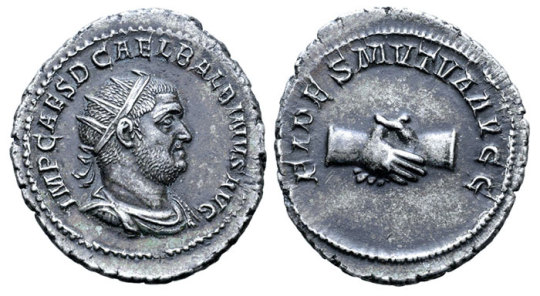
The gold aureus of Pupienus is apparently unique, although there is a well-known forgery by the 19th-century German counterfeiter Karl Wilhelm Becker (1772-1830). Just three gold aurei of Balbinus are known; one brought over $70,000 in a 2005 Swiss auction.
By Mike Markowitz.
#emperor#roman emperor#the briefest reigns of roman emperors#coins#collectable coins#roman coins#ancient coins#history#history news#ancient history#ancient culture#ancient civilizations#roman#ancient rome#roman history#roman empire#long post#long reads
23 notes
·
View notes
Text

AR Denarius 3.23g
OBVERSE: Bare head of Augustus right
REVERSE: Bull standing right
1 note
·
View note
Photo

*#sonofgod #augustus #caesar #jesusthechrist #thetrueemperor #americanpsycho* http://ChristianityOriginal.com/Empire In 42 BC, Julius Caesar was formally deified as a god "the divine Julius" (divus Iulius) after his assassination. His adopted son, Augustus (27 BC - 14 AD, during the decades just before Jesus started his ministry) thus became known as divi filius (son of god). Augustus Caesar, promoted himself as the Son of God by means of propaganda (Eg. *Coins)* through the ends of the Roman Empire, including the Roman-occupied nation of Israel. When the imperial stooges (the Herodians) in Israel came to trap Jesus in his words, he pointed out their hypocrisy. "Later they sent some of the Pharisees and Herodians to Jesus to catch him in his words. They came to him and said, “Teacher, we know that you are a man of integrity. You aren't swayed by others, because you pay no attention to who they are; but you teach the way of God in accordance with the truth. Is it right to pay the imperial tax to Caesar or not? Should we pay or shouldn't we?” But Jesus knew their hypocrisy. “Why are you trying to trap me?” he asked. “Bring me a denarius and let me look at it.” They brought the coin, and he asked them, “Whose image is this? And whose inscription?” “Caesar's,” they replied. Then Jesus said to them, “Give back to Caesar what is Caesar's and to God what is God's.” And they were amazed at him. Mark 12:13-17 The whole assembly rose and led him off to Pilate. And they began to accuse him, saying, *“We have found this man subverting our nation. He opposes payment of taxes to Caesar* and claims to be Messiah, a king.” Luke 23:1-2 https://www.facebook.com/photo.php?fbid=627157416109377&set=a.549191003906019&type=3
0 notes
Text
Old Currency Coins: A Look into the World of Numismatics
The Site may contain links to affiliate websites, and we receive an affiliate commission for any purchases made by you on the affiliate website using such links.
Numismatics is the study and collection of coins and currency. It is a hobby enjoyed by millions of people around the world, and old currency coins are among the most popular items sought after by collectors. These coins come from different countries and time periods and are valued for their rarity, historical significance, and beauty.
One of the most popular old currency coins is the U.S. Morgan silver dollar. These large silver coins were minted from 1878 to 1904 and again in 1921. They feature a portrait of Lady Liberty on one side and an eagle on the other. The coins are highly collectible due to their silver content, size, and historical significance. They were produced during a time of great economic growth in the United States, and they are considered an iconic symbol of American history.
Another popular old currency coin is the U.S. Indian Head penny, minted from 1859 to 1909. These pennies feature a design with a Native American in a headdress on one side and an oak wreath and shield on the other. They are highly prized by collectors for their beauty and historical significance. The Indian Head penny was produced during a time of great change in the United States, and it is considered a symbol of the country's westward expansion.
British gold sovereigns are also highly sought after by collectors. These gold coins have been produced since 1817 and are still minted today. They feature a portrait of the reigning monarch on one side and the image of St. George slaying the dragon on the other. They are considered a classic example of British currency and are highly prized for their historical significance and beauty.
Canadian silver dollars, known as "voyageur" dollars, are also popular among collectors. These silver coins were produced from 1935 to 1967 and feature a design of a canoe with fur traders. They are highly valued for their historical significance and beauty and are considered an iconic symbol of Canadian history.
Spanish gold doubloons are among the most historic old currency coins. These gold coins were once used as currency by the Spanish Empire and were produced from the 1500s to the 1600s. They feature a design with the Spanish monarch on one side and the royal coat of arms on the other. They are highly prized for their rarity and historical significance and are considered one of the most sought after coins in the world.
The Roman Coins 12 Ancient Collection is a unique and highly prized collection of Roman coins that spans the reigns of 12 different emperors. The collection provides an unparalleled insight into the history of the Roman Empire, featuring some of the most famous and significant Roman coins, such as the Julius Caesar Denarius, the Augustus Denarius, and the Nero Aureus. Each coin represents a unique period in the history of the Roman Empire, allowing collectors and historians to delve into the story of this great empire through the art and symbolism of the coins. The collection is highly sought after by numismatists and collectors around the world, as it represents a rare and valuable glimpse into the history of one of the most influential civilizations in human history.
In conclusion, old currency coins are highly valued by collectors for their rarity, historical significance, and beauty. The coins come from different countries and time periods and are considered iconic symbols of their respective histories. Numismatics is a fascinating hobby that allows collectors to delve into the world of old currency coins and uncover the secrets of the past. Whether you are a seasoned collector or a beginner, there is no doubt that old currency coins are a treasure worth exploring.
Thanks for reading, would like to know your thoughts and also if there are any other coins that you would like to share, please post in the comments below.
0 notes
Photo

Incredible Discovery 😮!!! Managed to save this Stunning Roman Silver Denarius Emperor Trajan 98-117 AD Minted In Rome. Trajan (Latin: Imperator Caesar Nerva Traianus Divi Nervae filius Augustus; September 18, 53 – August 8, 117 AD) was Roman emperor from 98 AD until his death in 117 AD. Officially declared by the Senate optimus princeps ("the best ruler"), Trajan is remembered as a successful soldier-emperor who presided over the greatest military expansion in Roman history, leading the empire to attain its maximum territorial extent by the time of his death. He is also known for his philanthropic rule, overseeing extensive public building programs and implementing social welfare policies, which earned him his enduring reputation as the second of the Five Good Emperors who presided over an era of peace and prosperity in the Mediterranean world. The monetary art under Trajan fails to show signs of ageing of the Emperor and introduced the bust showing shoulders and breast, usually bare. The images on the reverse show personifications like Abundantia and Pax but refer to the subjugation of Dacia, too. All denominations since the time of Augustus are present under Trajan and generally follow the Neronian weight reformation. A typical feature of the coinage is the amalgamation of the dupondius and the as. 2nd outing with the new Nox 900 Metal Detector Field 1 Program - Fe 0 - Sensitivity 24/25 - Recovery Speed 4/5 #roman #silver #history #rome #coin #metaldetektoring #metaldetektors #metaldetectinglife #metaldetectoring #metaldetecting #explore #hobby #outddors #instagood #instalike #instadaily #instagram #instahistory #minelab #minelabequinox #detector #detectorist #detection #relichunting #sondeln #coinhunting #dirtfishing #treasure #treasurehunting https://www.instagram.com/p/CqVnXfiqf-Z/?igshid=NGJjMDIxMWI=
#roman#silver#history#rome#coin#metaldetektoring#metaldetektors#metaldetectinglife#metaldetectoring#metaldetecting#explore#hobby#outddors#instagood#instalike#instadaily#instagram#instahistory#minelab#minelabequinox#detector#detectorist#detection#relichunting#sondeln#coinhunting#dirtfishing#treasure#treasurehunting
0 notes
Text

~ Denarius: Portrait of Augustus, First Emperor of Rome.
Place of origin: Caesaraugusta (Zaragoza, Spain)
Date: 19-18 B.C.; Minted during the time of Augustus (27 B.C.-14 A.D.)
Medium: Silver
#ancient#ancient art#ancient coin#ancient currency#coin#currency#numismatics#denarius#portrait#augustus#emperor#rome#zaragoza#spain#19 b.c.#18 b.c.#history#archeology#museum
206 notes
·
View notes
Text
My face is on the money
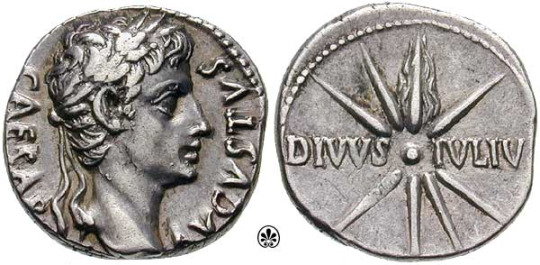
A denarius issued by Caesar Augustus. Photo: Classical Numismatic Group, Inc. http://www.cngcoins.com / Wikimedia / CC BY-SA 3.0
0 notes
Text
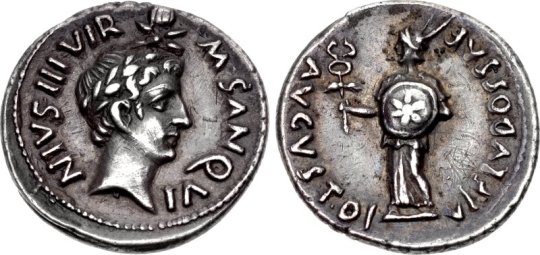
Denarius minted in 17 BCE by Marcus Sanquinius, one of the IIIviri monetales, to mark Augustus' holding of the Ludi Saeculares (Secular Games). On the obverse, the bust of the deified Julius Caesar; above his head is the comet seen after his assassination that was thought to mark his ascent to the gods. On the reverse, the herald of the Secular Games, in a costume evocative of the divine herald Mercury, including the caduceus.
The Secular Games were ostensibly held every 110 years, this period having been set by Etruscan soothsayers as the farthest limit of a human lifespan. Civil war prevented the holding of the regularly scheduled Games in 46 BCE; after Augustus became sole ruler, he chose 17 BCE to inaugurate a new Golden Age (saeculum aureum). The Games began with three days of prayer and sacrifice by Augustus and M. Agrippa, held both by day and by night. The daylight sacrifices were to Olympian deities (Jupiter, Juno, and Apollo/Diana), while the nighttime sacrifices honored deities with chthonic associations (the Moerae [Fates], the Ilythiae [goddesses of childbirth], and Terra Mater {Mother Earth]). The poet Horace composed a hymn for the occasion, the Carmen Saeculare, which was performed by choirs of boys and girls on the Palatine and then on the Capitoline. This event had several purposes: it celebrated peace and prosperity after many years of civil war; it advanced Augustus' program of religious reform and a return to the "old ways"; and it made absolutely clear that Augustus himself was the foremost figure in Roman state religion--not only in his official capacity as pontifex maximus, but by virtue of his close association (if not identification) with Palatine Apollo. The overall template would be used again by Domitian (88 CE) and Septimius Severus (204 CE), but Constantine declined to hold the Games in 314, bringing them to an end.
Photo credit: Classical Numismatic Group, Inc. http://www.cngcoins.com
#classics#tagamemnon#Ancient Rome#Roman Empire#ancient history#Roman history#Secular Games#Ludi Saeculares#Roman religion#Ancient Roman religion#religio Romana#art#art history#ancient art#Roman art#Ancient Roman art#Roman Imperial art#coins#ancient coins#Roman coins#Ancient Roman coins#denarius#metalwork#silver#silverwork#numismatics#ancient numismatics
89 notes
·
View notes
Photo

Denarius of Augustus, 27 B.C.E.E.-14 C.E., Brooklyn Museum: Egyptian, Classical, Ancient Near Eastern Art
Size: 11/16 x 3/4 x 1/16 in. (1.7 x 1.9 x 0.2 cm) 11/16 in. (1.8 cm) diam.
Medium: Silver
https://www.brooklynmuseum.org/opencollection/objects/36662
34 notes
·
View notes
Photo


A Rare Silver Coin Featuring Emperor Charlemagne Found in France
A rare 1,200-year-old silver coin featuring Charlemagne — one of the only known portraits made of the emperor during his lifetime — was recently rediscovered and promptly taken on a wild journey from a farm in France, to the bidding grounds of eBay and, finally, to a museum in Germany.
The coin's modern travels began when a man in France wanted to build a house but was short on cash. He remembered that he had inherited a coin collection from his grandfather, a farmer in the Paris region. After going through his grandfather's collection, the man discovered the Charlemagne coin, known as a denarius, and he put it up for auction on eBay.
"We have here some experts that regularly check what is on eBay concerning archaeology," said Frank Pohle, director of the Route Charlemagne, a group of municipal museums in Aachen, Germany, that focus on cultural history. "One of them told me 'Hey, there is a piece of money in eBay France that could be a real denarius of Charlemagne."
The museum decided to enter a bid. To their relief, they got the coin depicting Charlemagne and his imperial title: IMP(erator) AVG(ustus), a reference to Emperor Augustus, the first Roman emperor and a title used by the many emperors of the Roman Empire, whom Charlemagne was trying to emulate. (Pohle wouldn't reveal the coin's price, but said, "It was not that expensive. We are very content.")
Charlemagne (ruled A.D. 768 to 814), also known as Charles the Great, was king of the Franks and became the first ruler to unite Western and Central Europe after the fall of the Western Roman Empire in the fifth century A.D. Due to his political power, military might and close relationship with the Vatican, Charlemagne was crowned emperor of the Romans on Christmas day in A.D. 800.
So, perhaps it's no surprise that, in this coin portrait, Charlemagne "presents himself really as Roman emperor," Pohle told Live Science. "He has the laurel on his hat, which is quite unusual for Frankish kings. He is wearing a dress like a Roman general."
The portrait also reveals that Charlemagne had a round face, a mustache and a short neck, the latter a detail noted by Charlemagne's biographer Einhard, Pohle said.
Putting his portrait on the 0.7-inch-diameter (1.9 centimeters) coin "has something to do with his ambitions," Pohle told Live Science. "That type of coin is quite a good copy of what the Roman emperors did in their times … to use money as a piece of their own marketing purposes."
There are only about 50 individual denarii coins bearing a portrait of Charlemagne created in his lifetime. "Most [denarii] only have his name on it, no portrait," Marjanko Pilekić, a numismatist and research assistant at the Coin Cabinet of the Schloss Friedenstein Gotha Foundation in Germany, who is not involved with the newfound coin, told Live Science.
The back of the coin features a building, which has a Christian cross on it and looks like a mix between a Roman temple and a church, Pohle said.
When was it minted?
Museum experts have determined that the 0.5-ounce (1.5 grams) coin was likely minted in Aachen due to the city's importance, as that's where Charlemagne was born and later died. But the date of its minting is unclear. After being crowned Roman emperor, he didn't immediately use the title "Emperor Augustus" found on the coin.
"Although he was already crowned in 800, he didn't use that title [until] 812," Pohle said. "It had something to do with his diplomatic connections with Byzantium," also known as the Byzantine or Eastern Roman Empire. Instead, Charlemagne used the title "Emperor Governing the Roman Empire," according to Britannica.
Finally, in 812, the Byzantine Empire recognized Charlemagne's emperorship, so he started using the title found on the coin, making this a possible date for the coin's minting, Pilekić said. The coin also could have been minted in the year 813, when Charlemagne's son, Louis the Pious, was appointed as co-emperor and had similar coinage made.
"Charlemagne was ill during the last three to four years of his life, i.e. around 810-814, and was particularly concerned about the future of the empire," Pilekić said. "He had only one son left, whom he appointed co-emperor in 813. One theory is that the portrait coinage were created in the last year of his life. That is, at a time when he was probably striving for an orderly succession."
Another idea is that "these coins were specifically intended to commemorate the occasion of the emperor's coronation and therefore did not really serve as money like the other denarii of Charlemagne, which do exist in significantly larger numbers without a portrait and imperial title," Pilekić added.
It's hard to say how much this coin was worth at the time. "The amount of silver is quite low," but if you had 12 to 20 denarii, you could probably buy a cow, Pohle said.
By Laura Geggel.
#A Rare Silver Coin Featuring Emperor Charlemagne Found in France#charles the great#king of the franks#denarius#silver coin#silver#collectable coins#history#history news#ancient history#ancient culture#ancient civilizations#roman empire#roman history
125 notes
·
View notes
Text
Music For the Soul

by Alexander Maclaren
Christ The True Object of Our Endeavor
For to me to live is Christ, and to die is gain.
- Philippians 1:21
"Whose image and superscription hath it?" said Christ, " looking at the Roman denarius that they brought and laid in His palm. If the Emperor’s head is on it, why, then, he has a right to the tribute of it. And then He went on to say, " Render, therefore, unto Caesar the things that are Caesar’s, and unto God the things that are God’s." So there are things that have God’s head upon them, God’s image and superscription stamped, and these are your hearts, your whole constitution and nature. As plainly as the penny had the head of Augustus on it, and therefore proclaimed that he was emperor where it was current, so plainly does every soul carry in the image of God the witness that He is its owner, and that it should be rendered in tribute to Him.
And amongst all these marks of a Divine possession and a Divine destination printed upon human nature, it seems to me that none are plainer than this fact, that we can all of us thus give ourselves away in the abandonment of a profound and all-commanding love. That capacity unmistakably proclaims that it is destined to be directed towards God, and to find its rest in Him. As distinctly as some silver cup, with its owner’s initials and arms engraved upon it, declares itself to be " meet for the master’s use," so distinctly does your soul, by reason of this faculty, proclaim that it is meant to be turned to Him in whom alone all love can find its perfect satisfaction; for whom alone it is blessed and great to shed life itself; and who only has the authority over our human spirits.
I will not say that such emotions, wherever expended on creatures, are ever wasted. For however unworthy may be the objects on which they are lavished, the man himself is the better and the higher for having cherished them. The mother for her child, though her love and self forgetfulness and self-sacrifice may, in some respects, be called but an animal instinct, is elevated and ennobled by the exercise of them. The patriot and the thinker, the philanthropist, ay! even - although I take it to be the lowest of the scale - the soldier, who, in some cause which he thinks to be a good one, and not merely in the tigerish madness of the battlefield, throws away his life, is lifted in the scale of being by the deed. And so I am not going to say that when men love each other passionately and deeply, and sacrifice themselves for one another, or for some cause or purpose affecting only temporal matters, the precious elixir of life is wasted. God forbid! But I do say that all these objects, sweet and gracious as some of them are, ennobling and elevating as some of them are, if they are taken apart from God, are insufficient to fill your hearts; and that if they are slipped in between you and God, as they often are, then they bring sin and sorrow.
#Alexander Maclaren#Music For the Soul Devotional#Christ The True Object of Our Endeavor#Philippians 1:21#January 29#2022
3 notes
·
View notes